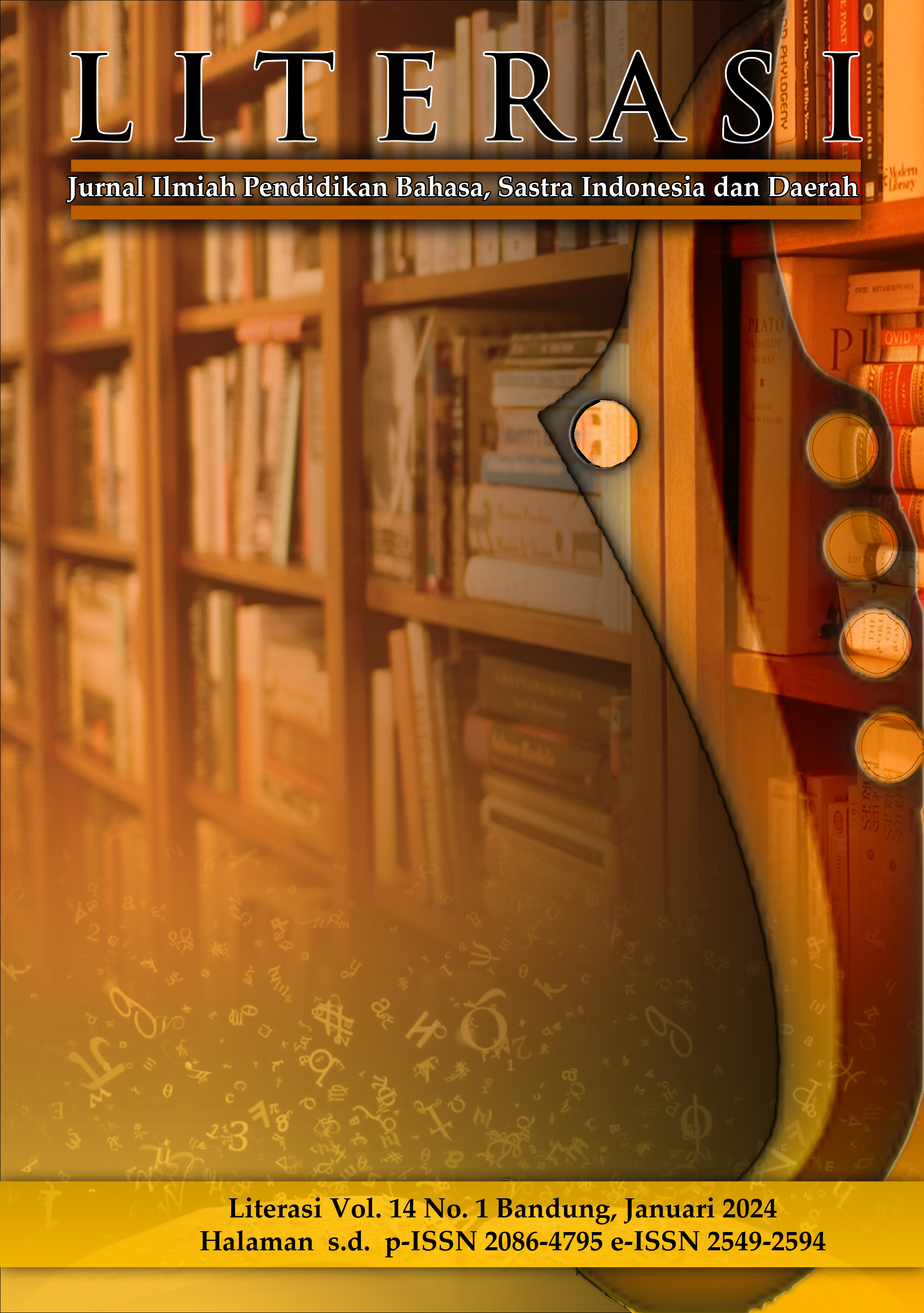MAKNA SEMIOTIKA PERANGKAT ADAT DALAM TRADISI MARPEGE-PEGE PADA MASYARAKAT BATAK ANGKOLA PADANGSIDIMPUAN
DOI:
https://doi.org/10.23969/literasi.v14i1.11400Keywords:
Meaning of Semiotic, Traditional Devices, Marpege-pegeAbstract
This research aims to determine the semiotic meaning of traditional devices in the ‘marpege-pege’ tradition in the Padangsidimpuan Batak Angkola. The method used in this research is the ethnographic method as determined by Spradley. Data was obtained through in-depth interviews with elements of society and “suhut” the elements or parties holding the event. The data analysis method used is de Sausure analysis (1859) by interpreting two dichotomies: signifier and signified. The results of his research show that there are 6 traditional devices that support the traditional “marpege-pege” procession. The semiotic meanings contained in the 6 traditional devices are “amak lappisan” which means a special seat, namely an entity that has a high position, “pinggan godang” and “haronduk” which means a respect, “Sipulut” (sticky rice) and “inti” (coconut mixed with brown sugar) which means to tighten. The relationship between the entities in the “marpege-pege” tradition, “Burangir” (betel), “soda”, “pining” (betel nuts) and “gambir” means a form of gratitude, “timbako” (tobacco) or (cigarette) has the meaning as a form of appreciation for community leaders who have present at traditional processions and “Abit” (cloth) has a simple meaning.
Downloads
References
Andarini, D. 2019. Kearifan Lokal Marsialapari Petani Salak Desa Sibangkua Angkola
Barat Kabupaten Tapanuli Selatan College Publishers.
Harahap, S. (2015). Budaya Marpege-Pege dalam Perspektif Sosiologi: Suatu Kajian Sosiologi atas Tindakan Budaya Masyarakat Batak Angkola. Jurnal Ilmiah Ilmu-Ilmu Sosial, 14(2), 111-124.
Hasibuan, A. S., & Setia, E. (2023). Marpege-Pege: A Tradition in Batak Angkola Padangsidimpuan. Tradition and Modernity of Humanity, 3(2), 42-47.
J. J. Spradley. (1979). "Ethnographic Interview". Orlando: Harcourt Brace Jovanovich College Publishers.
J. J. Spradley. (1980). “Participant Observation”. Orlando: Harcourt Brace Jovanovich
Koerner, E. F. (2013). Ferdinand de Saussure: Origin and development of his linguistic thought in western studies of language (Vol. 7). Springer-Verlag.
Mailin, E. E., & Siregar, J. (2018). Makna Simbolik Mengupa Dalam Upacara Adat Pernikahan Suku Batak Angkola Di Kabupaten Padang Lawas. Al-Balagh: Jurnal Komunikasi Islam, 2(1), 82-102.
Manullang, B., & Saragi, T. (2010). Kearifan Lokal Masyarakat Batak Angkola dalam Perspektif Pedagogi Adat: Sebuah Upaya Melestarikan Kearifan Lokal. Jurnal Pendidikan Progresif, 1(1), 33-46.
Mesini, M. (2021). REALITAS TRADISI MARPEGE-PEGE DI KABUPATEN TAPANULI SELATAN. Darul Ilmi: Jurnal Ilmu Kependidikan dan Keislaman, 9(1), 14-25.
Moleong, J. Lexy. 2014. Metode Penelitian Kualitatif. Bandung: Remaja Rosdakarya
Ritonga, S. K. (2020). Marpege-Pege Sebagai Tradisi Adat Batak Angkola Dalam Menikahkan (Kajian Tentang Persepsi Masyarakat Dan Tinjaun Hukum Islam). HUKUMAH: Jurnal Hukum Islam, 3(1), 81-94.
Saussure, Ferdinand de. (1859) "Nature of the Linguistic Sign." IN "Language and Language Learning: Theory and Practice," editing by Charles O. Frake. New York: Teachers College Press.
Wahyu & Nasrullah. 2011. Kearifan Lokal Petani Dayak Bakumpai Dalam Pengelolaan Padi di Lahan Rawa Pasang Surut Kab. Barito Kuala. Banjarmasin. Jurnal Komunitas.
Downloads
Published
Issue
Section
License
Copyright (c) 2024 Literasi: Jurnal Ilmiah Pendidikan Bahasa, Sastra Indonesia dan Daerah

This work is licensed under a Creative Commons Attribution 4.0 International License.
Hak cipta artikel yang diterbitkan di jurnal ilmiah dimiliki oleh penerbit, bukan penulis. Hal ini berkaitan dengan koordinasi hak akses untuk cetak ulang atau penggunaan lainnya. Dalam hal ini penerbit mempunyai keluluasaan untuk mempublikasikan artikel sesuai dengan kesepakanan Transfer Agreement (penyerahan hak cipta) antara penerbit dengan penulis.















